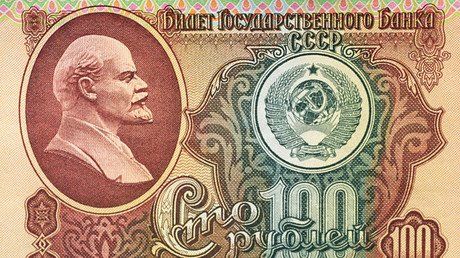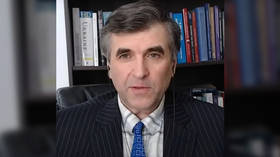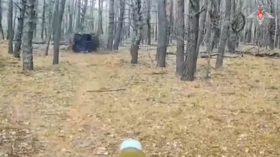1917 and its lessons for 2017: Learning from Lenin

If, as my fellow Op-Edger John Wight stated recently, ‘seismic’ was the only word to describe 2016 – what on earth can we say about 1917? This was the year of not one, but two, Russian Revolutions.
It also saw the US break with isolationism and enter the First World War – and the Balfour declaration – which eventually led to the establishment of the state of Israel.
READ MORE: 2016: The year Washington lost its mind
The dramatic events of one hundred years ago still shape our world today. It’s important therefore that we relive the year and study it closely, as there’s much we can learn from it – and in particular from the year’s most influential personality.
If Donald Trump was the Person of the Year in 2016, there’s no doubting who the key figure in 1917 was: Vladimir Ilyich Ulyanov, better known as Lenin. The bearded Marxist from Simbirsk began the year in exile, living with his wife in a bedsit at No 14 Spiegelgasse in Zurich, Switzerland, and ended it as the leader of the world’s first communist state.
After the February revolution, which saw Tsar Nicholas II abdicate and a Provisional Government take over in Petrograd, many who had been agitating for change thought it was a case of ‘Mission Accomplished’. But not Lenin. His return to his homeland in April was a historical game changer. “He called for immediate peace, immediate seizure of land by the peasantry, and immediate transfer of all power to the soviets,” records historian Christopher Hill, in his book ‘Lenin and the Russian Revolution.’
Russia’s been at war for 2 ½ years, losses horrific:
— Russian Telegraph (@RT_1917) January 1, 2017
- Almost 1mn troops dead & missing in action
- Over 2mn captured by enemy#1917LIVEpic.twitter.com/t9YwbyZIlD
The bourgeois Provisional government, at first dominated by conservative and liberal members, broadened its base to include leftists, but fatally, it remained committed to participating in a capitalists’ war.
The Bolsheviks were proscribed in July and Lenin went into hiding once again. But when General Kornilov launched a counter-revolutionary coup attempt in August, the pro-war Prime Minister Kerensky was forced to rely on the support of the Bolshevik-dominated soviets to stay in power. The days of the Provisional Government were numbered, as popular support for the Bolsheviks surged. On October 25 (November 7 in the Gregorian calendar), Lenin and his comrades made their move.
Later, Lenin wrote about the significance of what had been achieved: “For hundreds of years states have been built on the bourgeois model, and now for the first time a non-bourgeois state has been discovered.”
#1917LIVE: Relive the Russian Revolution as it happened with RT's unique Twitter project https://t.co/w7Wpo7oe0R
— RT (@RT_com) December 31, 2016
It’s likely that much of the western left-infected by liberalism and obsessed with identity politics and political correctness will mark the centenary of the October revolution this year with a smirk and say ‘nothing to do with us, mate’ and get on with writing their love letters to Hillary Clinton. But there are, I believe, important lessons to be learnt from the strategy employed by Lenin in 1917 – and the left dismisses them at its peril.
As was the case one hundred years ago, a corrupt, arrogant, and hideously out-of-touch establishment lies teetering on the brink. As was the case one hundred years ago, the gap between rich and poor is truly staggering. Only last January, Oxfam revealed that half of the world’s wealth is owned by just 62 people. Yes, that‘s right – 62.
Never forget what govt did: Took banker debt and made it OUR debt while letting bankers off. Then told us: You're living beyond your means.
— Marcus Chown (@marcuschown) January 3, 2017
But unlike 100 years ago, it’s the populist right – and not the left – that’s making all the headway. Instead of embracing working-class populism and positioning themselves at the forefront of anti-establishment protests as Lenin and the Bolsheviks did in 1917, the liberal-dominated western left of today seems scared of proletarian rebelliousness, and has instead sided on issue after issue with the neo-liberal militarist establishment.
We see this in the liberal-left’s attachment to parliamentarianism, and the failure to promote more democratic ways of organizing society e.g. the greater use of referenda, the introduction of workers’ councils and peoples’ assemblies and elected people’s courts (interestingly the attachment to Parliamentarianism didn’t seem to apply to Ukraine in 2014 when many ‘liberal-leftists’ in the West supported the violent overthrow of the democratically-elected government).
We also see it in the way that ‘bread-and-butter issues’ which affect the everyday lives of ordinary people are largely ignored with the focus instead on fighting culture wars and promoting wars of ‘liberal intervention’ in the Middle East, which only benefit elite interests.
The fact is that the liberal-left is as detached from working-class concerns today as were the ‘reformist left’ opponents of the Bolsheviks in 1917 – who could only say: “Please wait for the Constituent Assembly elections” when millions of Russians were starving. Lenin was under no illusions about ‘liberal democracy’ and who it benefited. “Democracy for an insignificant minority, democracy for the rich – that is the democracy of capitalist society,” he wrote in 1917.
He knew that Russian involvement in the war had to end. That land had to be given to the peasants without delay. That Russia’s economy had to be radically restructured. His slogan of “Peace! Bread! Land!” resonated throughout the country.
You don’t have to be a Bolshevik, or even a socialist, to admire Lenin’s clarity and sense of purpose.
“In 1917 it was the Bolshevik mastery of the ‘fact’ that was decisive,” says Christopher Hill. “The party knew exactly what it wanted, what concrete concessions to make to different social groups at any given stage, how to convince the masses of population by ‘actions’, its own and their own.”
The centenary of the October revolution and the ‘Ten Days That Shook The World,’ should galvanize the genuine left into action. But if the liberal cuckoos-in-the-nest have their way, it will be the right who once again forge ahead, with working-class support, in 2017.
Follow Neil Clark @NeilClark66
The statements, views and opinions expressed in this column are solely those of the author and do not necessarily represent those of RT.














